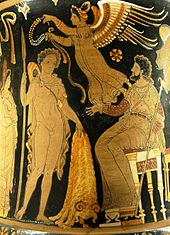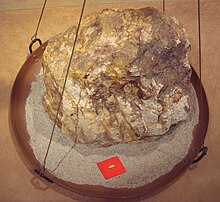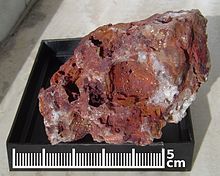History
Gold has been known and used by artisans since the Chalcolithic. Gold artifacts in the Balkans appear from the 4th millennium BC, such as that found in the Varna Necropolis. Gold artifacts such as the golden hats and the Nebra disk appeared in Central Europe from the 2nd millennium BC Bronze Age.
Egyptian hieroglyphs from as early as 2600 BC describe gold, which king Tushratta of the Mitanni claimed was "more plentiful than dirt" in Egypt.[33] Egypt and especially Nubia had the resources to make them major gold-producing areas for much of history. The earliest known map is known as the Turin Papyrus Map and shows the plan of a gold mine in Nubia together with indications of the local geology. The primitive working methods are described by both Strabo and Diodorus Siculus, and included fire-setting. Large mines were also present across the Red Sea in what is now Saudi Arabia.
The legend of the golden fleece may refer to the use of fleeces to trap gold dust from placer deposits in the ancient world. Gold is mentioned frequently in the Old Testament, starting with Genesis 2:11 (at Havilah) and is included with the gifts of the magi in the first chapters of Matthew New Testament. The Book of Revelation 21:21 describes the city of New Jerusalem as having streets "made of pure gold, clear as crystal". The south-east corner of the Black Sea was famed for its gold. Exploitation is said to date from the time of Midas, and this gold was important in the establishment of what is probably the world's earliest coinage in Lydia around 610 BC.[34] From the 6th or 5th century BC, the Chu (state) circulated the Ying Yuan, one kind of square gold coin.
In Roman metallurgy, new methods for extracting gold on a large scale were developed by introducing hydraulic mining methods, especially in Hispaniafrom 25 BC onwards and in Dacia from 106 AD onwards. One of their largest mines was at Las Medulas in León (Spain), where seven long aqueductsenabled them to sluice most of a large alluvial deposit. The mines at Roşia Montană in Transylvania were also very large, and until very recently, still mined by opencast methods. They also exploited smaller deposits in Britain, such as placer and hard-rock deposits at Dolaucothi. The various methods they used are well described by Pliny the Elder in his encyclopedia Naturalis Historia written towards the end of the first century AD.
The Mali Empire in Africa was famed throughout the old world for its large amounts of gold. Mansa Musa, ruler of the empire (1312–1337) became famous throughout the old world for his great hajj to Mecca in 1324. When he passed through Cairo in July 1324, he was reportedly accompanied by acamel train that included thousands of people and nearly a hundred camels. He gave away so much gold that it depressed the price in Egypt for over a decade.[35] A contemporary Arab historian remarked:
Gold was at a high price in Egypt until they came in that year. The mithqal did not go below 25 dirhams and was generally above, but from that time its value fell and it cheapened in price and has remained cheap till now. The mithqal does not exceed 22 dirhams or less. This has been the state of affairs for about twelve years until this day by reason of the large amount of gold which they brought into Egypt and spent there [...]
The European exploration of the Americas was fueled in no small part by reports of the gold ornaments displayed in great profusion by Native Americanpeoples, especially in Central America, Peru, Ecuador and Colombia. The Aztecs regarded gold as literally the product of the gods, calling it "god excrement" (teocuitlatl in Nahuatl).[37] However, for the indigenous peoples of North America, gold was considered useless, and they saw much greater value in other minerals, which were directly related to their utility, such as obsidian, flint, and slate.[38]
Although the price of some platinum group metals can be much higher, gold has long been considered the most desirable of precious metals, and its value has been used as the standard for many currencies (known as the gold standard) in history. Gold has been used as a symbol for purity, value, royalty, and particularly roles that combine these properties. Gold as a sign of wealth and prestige was ridiculed by Thomas More in his treatise Utopia. On that imaginary island, gold is so abundant that it is used to make chains for slaves, tableware and lavatory-seats. When ambassadors from other countries arrive, dressed in ostentatious gold jewels and badges, the Utopians mistake them for menial servants, paying homage instead to the most modestly dressed of their party.
There is an age-old tradition of biting gold to test its authenticity. Although this is certainly not a professional way of examining gold, the bite testshould score the gold because gold is a soft metal, as indicated by its score on the Mohs' scale of mineral hardness. The purer the gold the easier it should be to mark it. Painted lead can cheat this test because lead is softer than gold (and may invite a small risk of lead poisoning if sufficient lead is absorbed by the biting).
Gold in antiquity was relatively easy to obtain geologically; however, 75% of all gold ever produced has been extracted since 1910.[39] It has been estimated that all gold ever refined would form a single cube 20 m (66 ft) on a side (equivalent to 8,000 m3).[39]
One main goal of the alchemists was to produce gold from other substances, such as lead — presumably by the interaction with a mythical substance called the philosopher's stone. Although they never succeeded in this attempt, the alchemists promoted an interest in what can be done with substances, and this laid a foundation for today's chemistry. Their symbol for gold was the circle with a point at its center (☉), which was also the astrological symbol and the ancient Chinese character for the Sun. For modern creation of artificial gold byneutron capture, see gold synthesis.
During the 19th century, gold rushes occurred whenever large gold deposits were discovered. The first documented discovery of gold in the United States was at the Reed Gold Mine near Georgeville, North Carolina in 1803.[40] The first major gold strike in the United States occurred in a small north Georgia town called Dahlonega.[41] Further gold rushes occurred inCalifornia, Colorado, the Black Hills, Otago in New Zealand, Australia, Witwatersrand in South Africa, and the Klondike in Canada.
Because of its historically high value, much of the gold mined throughout history is still in circulation in one form or another.
Occurrence
Gold's atomic number of 79 makes it one of the higher atomic number elements which occur naturally. Like all elements with atomic numbers larger than iron, gold is thought to have been formed from a supernova nucleosynthesis process. Their explosions scattered metal-containing dusts (including heavy elements like gold) into the region of space in which they later condensed into our solar system and the Earth.[42]Because the Earth was molten when it was just formed, almost all of the gold present on Earth sank into the core. Most of the gold that is present today in the Earth's crust and mantle was delivered to Earth by asteroid impacts during the late heavy bombardment.[43]
On Earth, whenever elemental gold occurs, it appears most often as a metal solid solution of gold with silver, i.e. a gold silver alloy. Such alloys usually have a silver content of 8–10%. Electrum is elemental gold with more than 20% silver. Electrum's color runs from golden-silvery to silvery, dependent upon the silver content. The more silver, the lower the specific gravity.
Gold is found in ores made up of rock with very small or microscopic particles of gold. This gold ore is often found together with quartz orsulfide minerals such as Fool's Gold, which is a pyrite.[44] These are called lode deposits. Native gold is also found in the form of free flakes, grains or larger nuggets that have been eroded from rocks and end up in alluvial deposits (called placer deposits). Such free gold is always richer at the surface of gold-bearing veins owing to the oxidation of accompanying minerals followed by weathering, and washing of the dust into streams and rivers, where it collects and can be welded by water action to form nuggets.
Gold sometimes occurs combined with tellurium as the minerals calaverite, krennerite, nagyagite, petzite and sylvanite, and as the rare bismuthide maldonite (Au2Bi) and antimonide aurostibite (AuSb2). Gold also occurs in rare alloys with copper, lead, and mercury: the mineralsauricupride (Cu3Au), novodneprite (AuPb3) and weishanite ((Au, Ag)3Hg2).
Recent research suggests that microbes can sometimes play an important role in forming gold deposits, transporting and precipitating gold to form grains and nuggets that collect in alluvial deposits.[45]
The world's oceans contain gold. Measured concentrations of gold in the Atlantic and Northeast Pacific are 50–150 fmol/L or 10–30 parts perquadrillion (about 10–30 g/km3). In general, Au concentrations for Atlantic and Pacific samples are the same (~50 fmol/L) but less certain. Mediterranean deep waters contain higher concentrations of Au (100–150 fmol/L) attributed to wind-blown dust and/or rivers. At 10 parts per quadrillion the Earth's oceans would hold 15,000 tons of gold.[46] These figures are three orders of magnitude less than reported in the literature prior to 1988, indicating contamination problems with the earlier data.
A number of people have claimed to be able to economically recover gold from sea water, but so far they have all been either mistaken or acted in an intentional deception. A so-called reverend, Prescott Jernegan ran a gold-from-seawater swindle in the United States in the 1890s. A British fraudster ran the same scam in England in the early 1900s.[47] Fritz Haber (the German inventor of the Haber process) did research on the extraction of gold from sea water in an effort to help pay Germany's reparations following World War I.[48] Based on the published values of 2 to 64 ppb of gold in seawater a commercially successful extraction seemed possible. After analysis of 4,000 water samples yielding an average of 0.004 ppb it became clear that the extraction would not be possible and he stopped the project.[49] No commercially viable mechanism for performing gold extraction from sea water has yet been identified. Gold synthesis is not economically viable and is unlikely to become so in the foreseeable future.





